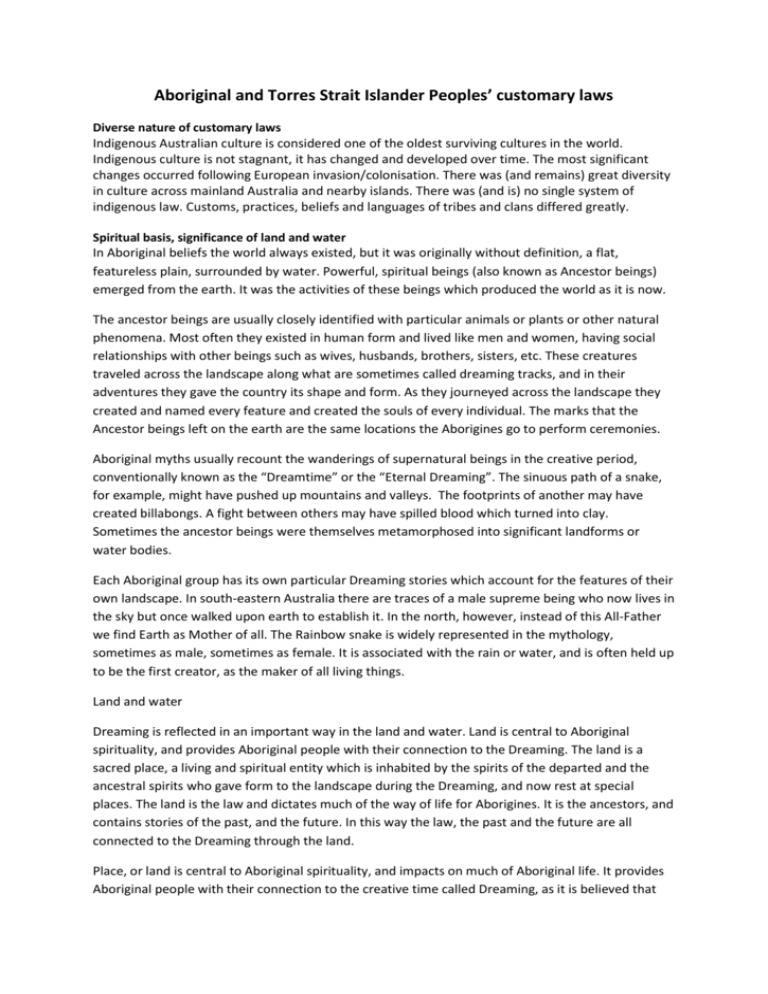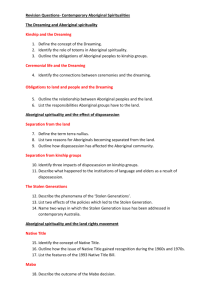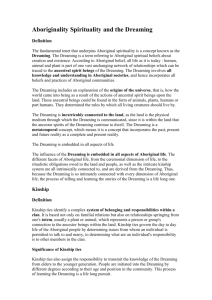File
advertisement

Aboriginal and Torres Strait Islander Peoples’ customary laws Diverse nature of customary laws Indigenous Australian culture is considered one of the oldest surviving cultures in the world. Indigenous culture is not stagnant, it has changed and developed over time. The most significant changes occurred following European invasion/colonisation. There was (and remains) great diversity in culture across mainland Australia and nearby islands. There was (and is) no single system of indigenous law. Customs, practices, beliefs and languages of tribes and clans differed greatly. Spiritual basis, significance of land and water In Aboriginal beliefs the world always existed, but it was originally without definition, a flat, featureless plain, surrounded by water. Powerful, spiritual beings (also known as Ancestor beings) emerged from the earth. It was the activities of these beings which produced the world as it is now. The ancestor beings are usually closely identified with particular animals or plants or other natural phenomena. Most often they existed in human form and lived like men and women, having social relationships with other beings such as wives, husbands, brothers, sisters, etc. These creatures traveled across the landscape along what are sometimes called dreaming tracks, and in their adventures they gave the country its shape and form. As they journeyed across the landscape they created and named every feature and created the souls of every individual. The marks that the Ancestor beings left on the earth are the same locations the Aborigines go to perform ceremonies. Aboriginal myths usually recount the wanderings of supernatural beings in the creative period, conventionally known as the “Dreamtime” or the “Eternal Dreaming”. The sinuous path of a snake, for example, might have pushed up mountains and valleys. The footprints of another may have created billabongs. A fight between others may have spilled blood which turned into clay. Sometimes the ancestor beings were themselves metamorphosed into significant landforms or water bodies. Each Aboriginal group has its own particular Dreaming stories which account for the features of their own landscape. In south-eastern Australia there are traces of a male supreme being who now lives in the sky but once walked upon earth to establish it. In the north, however, instead of this All-Father we find Earth as Mother of all. The Rainbow snake is widely represented in the mythology, sometimes as male, sometimes as female. It is associated with the rain or water, and is often held up to be the first creator, as the maker of all living things. Land and water Dreaming is reflected in an important way in the land and water. Land is central to Aboriginal spirituality, and provides Aboriginal people with their connection to the Dreaming. The land is a sacred place, a living and spiritual entity which is inhabited by the spirits of the departed and the ancestral spirits who gave form to the landscape during the Dreaming, and now rest at special places. The land is the law and dictates much of the way of life for Aborigines. It is the ancestors, and contains stories of the past, and the future. In this way the law, the past and the future are all connected to the Dreaming through the land. Place, or land is central to Aboriginal spirituality, and impacts on much of Aboriginal life. It provides Aboriginal people with their connection to the creative time called Dreaming, as it is believed that the Ancestor beings formed the features of the land after traveling the earth, and now rest in certain places known as sacred sites. Place is strongly associated with totemism and kinship which are important aspects of Aboriginal spirituality. Place is an important element in determining one's kinship relationship with others and can in some cases also determine one's totem. Sacred sites provide locations for the performance of ceremonies related to totemism such as balance or increase rites. Land is valued as a whole rather than by the resources it contains. It is not seen as a separate entity to the individual, but rather, the land and humans are an enmeshed whole. The land is viewed as the Mother; it provides food and shelter, and it is from the earth that the Ancestral beings created all things. The land is a living and spiritual entity, inhabited by ancestors of the past and the creative ancestor beings. It is the law and contains stories of the past, the future and the way things should be done in the present. Place, or land, is a pivotal feature of Aboriginal religion and it's performance. This is demonstrated in the centrality of place in the arts of Australian Aboriginal cultures. English/European law - right to possess/own land - land has monetary value - land can be modified/developed for profit - land can be bought, sold, inherited ATSI customary law - land is sacred/cannot be owned - land has spiritual value - land should be maintained and protected (particularly sacred sites) - land belongs to the community, ancestors and descendants. These differences led to misunderstandings about land ownership and partly resulted in the description of Australia as "terra nullius" (land belonging to no-one/uninhabited land). Family and kinship Aboriginal society and life is made up of elaborate kinship relations or structures. These kinship systems are believed to have been established in the Dreamtime and provide a framework for law enforcement through processes of reciprocity. It is believed that Aboriginal communities were divided into sections or sub-sections (kin groups) by the ancestors. Those belonging to the same section are said to: "...have the same flesh, owing to their coming from a common ancestor..."._ Kinship is usually passed on matrilineally, and one's kin group determines their relationship with every member of the community. In Dreaming stories, the ancestor spirits are also related to each other through complex kinship structures. Customary Law within Aboriginal life is reliant upon a social, political and judicial structure within Aboriginal society which has been ultimately derived from the Dreaming. This structure is directly related to the kinship structure of the community. Kinship relations place specific taboos on individuals which, if broken, have prescribed punishments taken from Dreaming stories. All kin relationships carry certain obligations and rights which need to be respected and which also form a part of Aboriginal law. Ritual and oral traditions ATSI laws are passed on from one generation to the next by word of mouth as there was no stand writing system. Laws were explained and reinforced in relation to Dreaming stories through the performance of rituals and ceremonies involving dancing and storytelling. Different people within a community have different levels of knowledge about the laws and related beliefs. Elders in the community have greater knowledge and pass this knowledge on to younger members of the community through various stages of initiation. There may also be knowledge, rules and laws specific to particular groups (i.e. women). Knowledge was/is only available to community members. Outsiders are not included. Laws can include issues such as tribal boundaries, taboos and daily relationships. Mediation and sanctions The community, and particularly the family, are central to dispute resolution according to customary law. Rather than using a formal system such as a court, discussion and meeting take place to assist dialogue between the different parties and to decide on the correct course of action. Mediation between the parties is an important part of this process. Central to Aboriginal law is the concept of reciprocity. Every service, act or gift must be repaid or compensated in some way. The significance of an exchange is not valued in a quantitative way but rather valued as an act of reciprocity. The value of the act lies in the quality of the encounter between the people involved. All members of the community are required to follow and enforce customary law, however the elders guide decisions about punishments. Examples of punishments are: • shaming • exile • spearing/beating death (less frequent today) Relevance to contemporary Australian law A key problem in the incorporation of customary law into Australian law is the idea that everyone should be treated equally under the law. As a result, while there is increasing recognition of indigenous people as landholders, there is still reluctance to formally incorporate customary law into Australian law. Aspects of conciliation and mediation have been incorporated into Australian law, and sometimes if a ATSI person is charged with a crime customary law may be used. Examine the characteristics of Aboriginal and Torres Strait Islander Peoples’ customary laws Outline the extent to which Aboriginal and Torres Strait Islander Peoples’ customary laws have been integrated into Australian law










